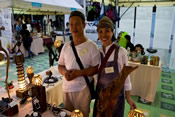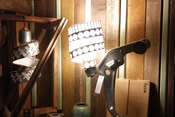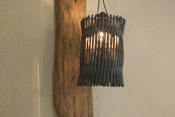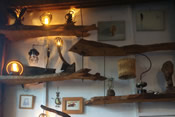
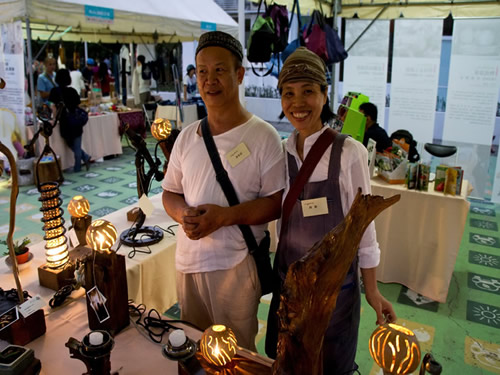 |
| The Red Cowboy (left) and Amo, his wife, introducing household items they recreate from waste material. |
By Li Wenxin (Staff of Chengdu Wanshi Nature Education Centre, a PCD partner organisation in Chengdu, Sichuan. Li is responsible for nature education, such as farm visits and nature-experience activities.) (The titles and subtitles of this article are added by PCD editor.)
|
Editor's note: On January 5-14, 2016, Li Wenxin went to Taiwan for an exchange on Taiwan’s experience in community building. The exchange was coordinated by the Sichuan Programme Office of PCD. The purpose of the trip was to study Taiwan’s experience in fostering ecology-friendly practices and community governance for urban and rural sustainable development, and Taiwan’s exploration into alternatives to mainstream economic development through urban-rural cooperation. During the 10-day programme, participants visited about 12 sites, including a welfare organisation, an ecological community, a community centre, a farmers’ market, a community kitchen, a community development organisation, and Amo’s Home, a well-known recycling workshop and handicraft shop. In this article, Li shares what she learnt and observed on the trip, in particular the visit to Amo’s Home, and reflects on consumerist culture in contemporary society. |
What are material goods? They come into our lives in a variety of shapes and meet our needs with their varied functions. A bowl and a pair of chopsticks are material goods. To feed ourselves, we need something to hold food and to put food into our mouths. Garments are material goods; we need clothes to cover our bodies. Mobile phones are material goods; they make it easier for us to communicate with others. These are material goods that fulfil our practical needs.
Resources diminishing rapidly as a result of our unrestrained desire for material goods
As society develops, our need for material goods grows and reaches new levels. Goods are desired now not only to meet our practical daily needs, but also to satisfy our ever-expanding wants and even to show off our social status. We want all sorts of tableware to adorn our dining table and we buy new cutlery simply because we are in the mood. We want to dress fashionably or wear clothes that signify a certain social status. We want a new mobile phone with more functions in order to maintain a fast-paced lifestyle and for entertainment. As consumerism prevails, we have lost control over our desire for material goods. We consume without moderation and we replace what we own at an unprecedented rate. We are, in other words, exhausting the resources of the earth at an unprecedented speed.
However, even in such times and under such circumstances, there are people who have adopted an entirely different stance and attitude with their simple and persistent actions. Last January I was fortunate to have the opportunity to join a trip to Taiwan organised by PCD’s Sichuan Programme Office to learn about and exchange experiences on community building. We visited various community organisations and learnt how they had been building their communities. In the process I gained a new understanding of material goods and new ideas about consumption.
Economic development can be resource-friendly
The economic development of a community does not have to be built on a model that feeds on natural resources. After the earthquake on September 21, 1999, faced with the need for reconstruction, the community of Taomi, in Nantou County's Puli Town turned the crisis into an opportunity with the help of the local authorities, including the Soil and Water Conservation Bureau, the Forestry Bureau and the county government. A survey of the natural resources of Taomi was carried out after the earthquake. It was found that in Taomi there were all sorts of ecological resources that were not found in other towns and villages, including many species of frogs, dragonflies, birds, and other creatures. Making use of its unique natural resources, Taomi has reorganised its economic activities and become a local eco-village in which economy, ecology, culture, everyday life and tourism are integrated. To develop eco-tourism, local people were trained as eco-tour guides and villagers opened guesthouses and restaurants that served local food. By using ecological resources to promote economic development, not only has the community protected their local natural resources, they have also gained economic growth.
Treehope Ecohub is a multi-functional space for organising environmental protection activities. Formerly a prawn fishing pond, it was rebuilt and designed with permaculture principles and has adopted the win-win approach of being environment-friendly and supporting economic development at the same time. “Tree” represents lush green permaculture; “hope” is a transliteral sound for the Chinese character of “合” which means cooperation, and here the character refers to the cooperation among groups of people; “hub” represents a space that grows with time. Believing that “problems are opportunities, and you have strength as long as you have hope”, for a year Treehope worked hard to build on the prawn fishing park and make adaptations by combining the buildings and the environment into an organic whole.
The original prawn fishing pond is now a display venue for the products of Treehope and the Hope Market. Careful planning and design of the space has saved the natural resources from being depleted by filling up the prawn fishing pond. When the walls of the original toilets were removed, the question of how to rebuild the sewer came up. Normally it would simply be refilled with cement, but instead Treehope turned it into another green space—an ecological pond. Charcoal is put into the pond to purify the water and small fish are bred and aquatic plants grown. A window was installed on the ceiling right above the pond to bring in light and fresh air. When it rains, rainwater is collected in the pond and when there is too much water, it is discharged with a drain. In this way, the volume of water remains stable and the pond will not flood.
Based on old buildings, Treehope’s attitude towards everyday life is also inspiring. We learnt how to make beancurd pudding at Treehope, and before we had our lunch, Mr. Meng Kai said a prayer of thanks. From all this, I feel that what Treehope embodies is a lifestyle. Material goods express the way one lives one’s life. They are part of our daily life and not there just to satisfy our consumerist desire. We treat material goods with love, and in this way they gain their meaning. Treehope sells products but does not emphasise consumption. The rainforest coffee sold at Treehope raises awareness of the issues of fair trade and rainforest conservation. The beancurd reminds you of the issue of genetically modified organisms (GMO) and the conservation of primary seeds.
Our relationship with material goods is like a marriage
As our needs grow infinitely, consumption also expands infinitely. We feel that our desire can never be satisfied. Why? I think the answer can be found in these words: “When we say ‘live our lives’, we are not talking only about consumption. To live a good life and to be beautiful and happy is not the same as to spend more, to be able to spend more, or to be able to buy expensive stuff. To live, one has to ‘take part’ and only then will one be able to rediscover what it means to be happy.” (Quoted from Hope Market’s website).
It seems to me that there are some similarities between our relationship with material goods and marriage. If we were hoaders, our relationship with material goods is like a marriage that is burdensome, confined and confused. A wasteful relationship between material goods and their owners is similar to a short-lived marriage. A healthy and caring relationship between material goods and their owners is like a long-lasting marriage of mutual love and respect.
During our trip, we also visited Amo’s home, a well-known family that specialises in making and selling things made from recycled goods. We met the couple, Amo (the wife) and the “Red Cowboy” (the husband), in the shop. Their relationship with the goods that they recreate is that of the third kind of marriage mentioned above. One can feel the love that goes into each and every object that they repurpose and sell in their shop, Shih Sundry Goods.
Recycling is never easy
The Red Cowboy used to be a skilled worker in a car-repair workshop. His hands were always black because of the grease on the machines that he handled. In Taiwan, workers in this trade are called “black-hands”. Working in car-repair workshops, he had to deal with auto parts. The raw material of his creative work is therefore usually used auto parts: car brakes, springs of shock absorbers, windscreen wipers, exhaust pipes, transmission gears, stabiliser bars and steel sheets, used iron sheets, coconut shells, loofa scrubs, bamboo, wood. Scraps and waste that nobody cares about are repurposed by the Red Cowboy and Amo. With their creative hands, they skilfully remake and reuse old and used materials in Shih Sundry Goods’ experimental multi-functional space. The trunk of a toppled tree and a steel sheet from a car are turned into a table; a brake, the spring of a shock absorber, windscreen wipers of a car and a rattan pillow are put together to make a table lamp; a clutch plate becomes a clock; the handrail of the stairs to the upper floor is made from used auto parts of a car. Discarded wood blocks are used to build the display counters and to decorate the bar table. Used cooking oil is recycled and made into soap for cleaning. Every recycled object is rejuvenated by the couple’s lifestyle. As time goes by, these objects gain a life of their own.
Recycling is never easy. At least this is how I feel. In the case of a piece of old wooden furniture, you have to first remove the paint from the surface of the wood before you can see its natural colour. It is painstaking and time-consuming, and if you do not enjoy doing it, it is hard to complete even this process. However, Amo and the Red Cowboy find joy in bringing old things back to life. Both of them cherish material goods and enjoy recycling stuff that others throw away. They enjoy the satisfaction and happiness of ownership of but are not burdened by material possessions. I think this is probably the highest level of relationship one can have with material goods.
“A grain of rice reminds us that it takes a lot of hard work to cultivate it; a thread of silk or hemp reminds us that much labour has gone into producing it.”
How can you be certain that you want to spend the rest of your life with someone? To this question, some answer: Ask yourself if for their sake, you are willing to give up another better person whom you may meet later. In the same way, before you buy something, you can consider whether you are willing to forego another better object later. There is an ancient saying (Zhu Zi’s Maxims on Family Management): “A grain of rice reminds us of the hard work needed to cultivate it; a thread of silk or hemp reminds us of the strenuous labour that has gone into producing it.” When we own something, we must cherish it, make the best use of it and let it fulfil its function to the maximum. When we want to discard something, we should think in the way Amo and the Red Cowboy think and see if it can be put to another use, or give it to someone who needs it more than we do. We should ensure that everything is fully used and not discarded carelessly.
If we think carefully when we acquire or discard material goods, everything will then be cherished and well used and the resources of the earth will not be exploited and used excessively.
Cherish resources, cherish one’s self
At Amo’s Home, I bought The Black-Hand Player, a book written by Amo. She autographed it and wrote on the title page: “To cherish resources is to cherish one’s self.” I give these words to the reader of this article.


